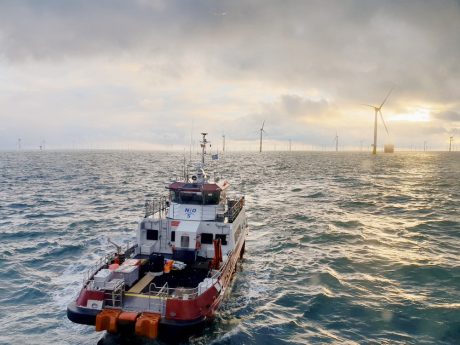Stewarts’ client TR developed permanent neuropathic pain after being electrocuted while carrying out his job as an offshore geotechnician aboard a vessel in Danish waters. Senior Associate Rebecca Huxford, who led TR’s claim for compensation as a result of his injuries, reviews his case.
Background
TR, a Scottish resident, was an offshore worker specialising in geotechnical site investigations and surveys for the installation of wind turbines, cable routes and desalination plants. He was involved in a workplace incident on 23 July 2022 when working onboard a Norwegian-registered vessel chartered by a Dutch company (KW) for whom he had been contracted to work via an English company specialising in supplying offshore personnel (FD).
At the time of the incident, the vessel was in Danish waters. At approximately 11.30am, TR was deploying an ultra-short baseline acoustic positioning system (USBL) pole from the open deck of the vessel. As TR picked up the remote for the USBL pole, he experienced a potentially lethal electric shock in his right hand. TR was thrown back by the shock. He immediately had a sharp pain in his little finger and along the inside of his arm. The shock exited through his big right toe, causing the nail to split and fall off.
TR immediately experienced swelling and stiffness of the arm, and loss of feeling, grip and power. TR was unable to continue with the day’s operations, but the captain of the vessel decided against medical evacuation. When the ship eventually docked in Denmark a few days later, an offshore medic advised TR that had they known the severity of the shock at the time of the incident, they would have recommended medical evacuation. TR caught a commercial plane home later the same day.
KW completed a full investigation into the incident, and it was found that water ingress into the remote had caused it to short-circuit. TR notified FD of the injury, and FD recommended that TR pursue a claim via a direct settlement scheme it had in place. Through the scheme, which was managed by FD’s loss adjusters, TR received private medical treatment and rehabilitation as well as two interim payments to replenish his lost earnings while he remained unable to work.
TR instructed Stewarts’ specialist International Injury team when he realised the potential extent of his claim and that it was not suitable for the direct settlement scheme FD had been encouraging him to use. Senior associate Rebecca Huxford led the case.
How was the client affected by the injury?
As a consequence of the electric shock, TR developed permanent neuropathic pain, which was not alleviated by surgery or treatment. He now lives with permanent altered sensation and reduced dexterity. TR also developed severe post-traumatic stress disorder. TR was unable to satisfy the Standards of Training Certification and Watchkeeping (STCW), which are internationally recognised rules that direct the knowledge and skills mariners need to perform their jobs safely. Without this certification, TR was precluded from returning to any offshore work.
How did Stewarts’ personal injury team approach the claim?
A claim was initially made against FD on the basis that TR had been contracted to work for KW via FD, and FD was prepared to deal with his claim through the direct settlement scheme. Following an initial approach by Stewarts, FD instructed English solicitors, who questioned whether England and Wales was the correct place to bring the claim, given that TR was resident in Scotland and the incident occurred off the coast of Denmark.
FD denied that there was an employment relationship between TR and FD and, therefore, the claim should be directed to KW. However, it did confirm that it had entered into a contract with KW. This could potentially mean that FD had to indemnify KW for any claims made against it. Therefore, we sent letters of claim to both FD and KW.
In the background, we made enquiries with Danish and Norwegian lawyers about pursuing claims in those jurisdictions if the defendant continued to contest whether England and Wales was the most appropriate place for the case to proceed.
We had already begun to obtain expert evidence to determine TR’s condition and prognosis for the future. While we waited for the defendants’ response, we considered this expert evidence and prepared a valuation of TR’s claim. In late December 2024, we put forward a settlement offer to both defendants.
KW instructed its own English solicitors, but the case was swiftly transferred to FD’s solicitors, who subsequently represented both defendants. No information concerning the contractual relationship between the defendants was forthcoming. We requested disclosure of any relevant documents, as this was of significant importance in determining in which jurisdiction to start court proceedings. This was especially relevant as the three-year anniversary of the claim was approaching and TR needed to bring proceedings before then to preserve his right to claim.
How was the claim resolved?
TR made an offer under part 36 of the English Civil Procedure Rules (which is a formal settlement proposal that carries specific cost consequences if not accepted and later beaten at trial). This was rejected, but the defendants subsequently made their own Part 36 offer to settle the claim, which TR rejected. They also proposed instructing their own medical experts in England.
The main issue in dispute was the value of the TR’s future loss of earnings claim and the value of any future contracts he might have secured. A vocational occupational therapist had identified alternative employment roles if TR retrained. We accepted that TR had residual capacity to work, but given his age, injuries, dyslexia and remote location, TR would likely find it difficult to obtain employment in the areas identified. Plus, any residual earnings would be substantially less than what he had been earning. After a long exchange of offers, the claim eventually settled for £1,125,000.
What were the challenging aspects of the claim?
This case had complex features in respect of jurisdiction and applicable law. It emphasises the need to push for disclosure of the contractual relationship between the parties, as often this is relevant to the question of jurisdiction and applicable law. It was clear that FD had provided an indemnity to KW, and this likely had English jurisdiction and applicable law provisions. Hence, the solicitors latterly proceeded in a way that, while not determinative, implied a concession on English jurisdiction (including, part 36 offers, Calderbank offers (ie offers without prejudice save as to costs) and proposing medical experts in England).
Client testimonial
TR said: “Since instructing Stewarts, I found Rebecca and her team very helpful and informative. They all responded promptly to any issue that arose, and the advice I was given was clear and well communicated. I would definitely recommend Rebecca and her team from Stewarts to anyone in need of good legal guidance.”
How can we help with your claim?
Stewarts has a number of international injury specialists with experience in acting for clients who have been injured while working abroad and at sea. To discuss your prospects of a successful claim, please contact us today or complete our online enquiry form.






